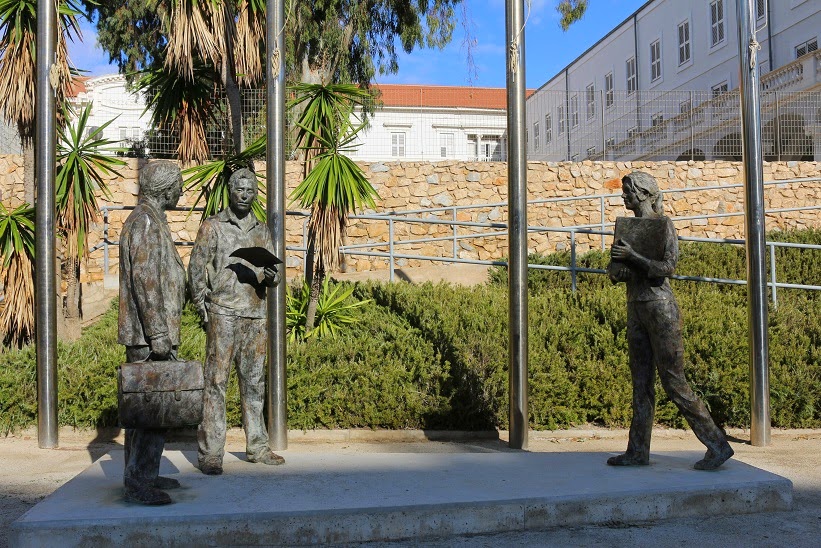Lanzarote is a volcanic island that dates back about 15
million years ago. Located on the African Coast it is uniquely part of Spain as
are the other 6 Canary Islands, and yet border the African Continent. I only
visited three.
You can tell immediately that it is a volcanic island, the
terrain is pure black, and there is a crunch beneath your feet because you’re
walking on tiny volcanic pebbles. This island has more than 300 volcanoes, and
perfect weather year round, it is eco friendly and as a result it is a great
tourist destination, it’s perfect for tourists looking for serenity and an
unimaginable landscape.
The history is rich and goes back to Greek writers, Homer, Plato and Plutarch. The first known inhabitants were the cave dwellers
Guanches who arrived somewhere in the 1st or 2nd century
BC. The first European visitor was
Lanzarotto Marcello, who settled in the early 14th century. My guess
is that is why the island is called Lanzarote. By the end of the 15th
century, Spain had conquered all seven islands, and to this day they remain
uniquely Spanish.
The first thing you notice is the black soil, the second is
that all the houses are painted white, the doors and window trim must be either
painted brown or green, or if you live by the sea blue. No other colors are
allowed on the island.
There is only one high rise, or what is considered a high
rise by locals-maybe 12 stories-rising like a lone needle from afar-they are no
longer allowed to be build anything tall because of the possibility of volcanic
eruptions.
There is a magnificent cactus garden designed by a local resident
and much beloved artist, Cesar Manrique. According to our guide, he is said to
be the man who gave Lanzarote a future filled with potential and hope. The
garden is designed in a quarry, it has the feel of a Roman theatre, surrounded
by volcanic rock, iron gates, steps leading down, up, and long narrow passages,
it is modern and totally captivating. It houses over 1000 species of cactus,
along with a few of Manrique’s mobiles. The garden is truly breathtaking,
modern, functional, so peaceful that you never want to leave.
There is a café on top with amazing views to the gardens
below, and alongside the café a few steps down is a small gift shop. At the
time that we were there the phone lines were down, and people couldn’t charge
their purchases, they had some lovely books on the design and history of the
garden. I have never seen a design like this before, it’s one of the most
unique places I have visited-I took picture so I can share them with you.
The tour also included a visit to Cesar Manrique’s house,
designed by him on 5 volcanic bubbles, basically big holes in the volcanic
land. He used each bubble to create wonderful open spaces, sitting options,
each one unique and vibrant. All were connected by narrow passages, painted a
bright white. He included a pool, small
dance floor, sitting rooms, all were open to the environment, with plants,
creative lamps, a magical place, he even had what would for us pass as a
barbeque grill.
His own art collection is now part of the museum as well. He
is much beloved in the area, and our tour guide pointed out several times that
he was killed in a car accident, she even pointed to the exact spot on the roundabout,
as we were heading to visit his home.
As an indirect result Lanzarote has a brand new highway
system that is efficient and much safer. According to her there were many
deaths on the old roads. There are no traffic lights but roundabouts are everywhere.
It is a small community, deeply rooted to the volcanic earth, and Cesar
Manrique helped bring that closeness about. Cesar Manrique was instrumental in
making the people of Lanzarote aware of their unique and wondrous heritage.
We also visited an agricultural museum, El Patio. To call it
a journey to the past would be perfect. The museum houses farming equipment
that dates back to the 1840’s. We were treated to local goat cheese, green
olives, homegrown tomatoes, along with crackers and the local wine. After which
we fed the chickens, rooster and one peacock the leftovers, they patiently
waited for us to finish.
A charming place, although I found the scarecrows dressed as
the local old farmers, sitting in a dilapidated, run down old house that was
dimly lit downright eerie.
Cheers,
Margot
Justes
Blood Art
A Fire Within
A Hotel in Paris
A Hotel in Bath
Hot Crimes Cool Chicks
www.mjustes.com




































